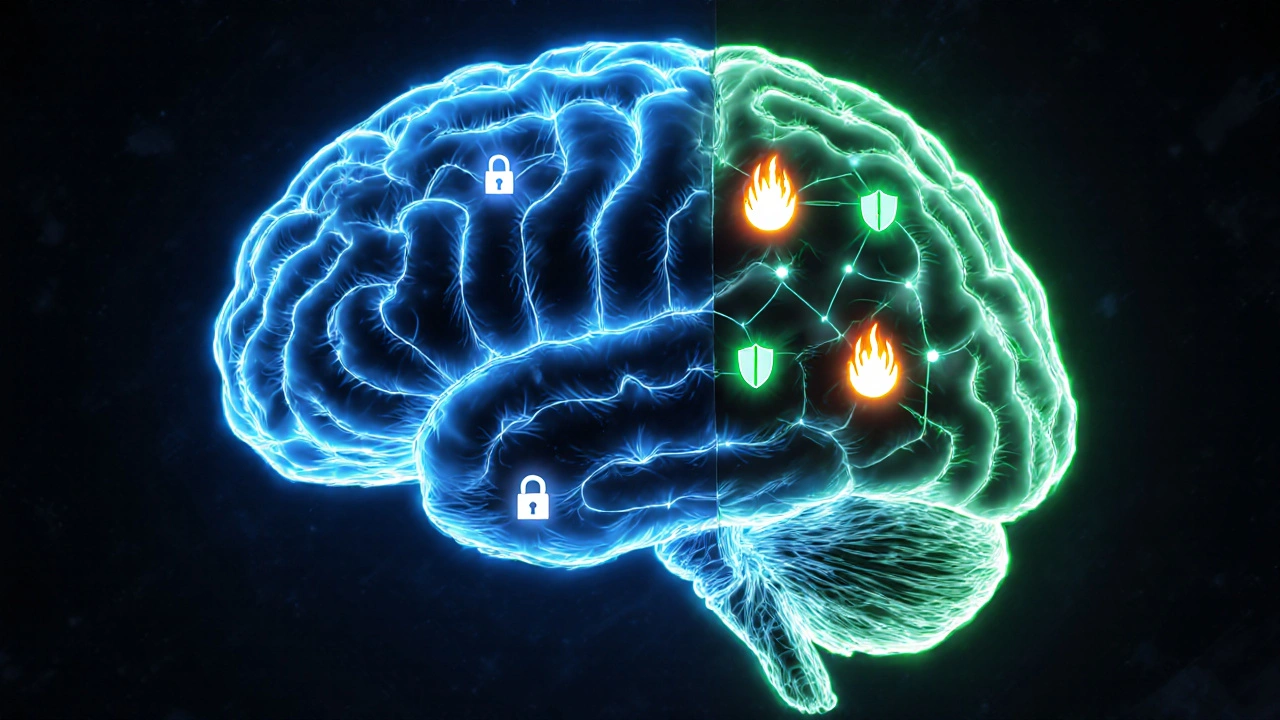LDN vs Alternatives Comparison Tool
Select a condition and an alternative agent to see how they compare:
Low Dose Naltrexone (LDN) is a small‑dose formulation of the opioid antagonist naltrexone, typically 1.5‑4.5mg per day, used off‑label to modulate the immune system and ease chronic pain. While the standard 50mg tablet blocks opioid receptors for addiction treatment, the low dose triggers a brief rebound of endogenous opioids, which many clinicians say resets immune signalling. The buzz around LDN grew after a handful of early‑2000s case series hinted at benefits for multiple sclerosis, fibromyalgia and Crohn’s disease. If you’re hunting for an alternative, you’ll run into a menu of options - from classic analgesics to newer biologics - each with its own trade‑offs.
How LDN Works: The Science in Plain English
The key player is the opioid receptor (a protein on nerve and immune cells that binds endogenous opioids like endorphins). At low doses, naltrexone briefly blocks these receptors for about an hour, prompting the body to surge its own endorphin production once the block lifts. This surge is thought to dampen inflammation by influencing autoimmune disease pathways (immune processes that mistakenly attack healthy tissue). The result is a modest, long‑term reduction in inflammatory cytokines such as TNF‑α and IL‑6.
Because the dose is so low, LDN avoids the intense withdrawal symptoms seen with the 50mg version. Most patients report only mild, transient nausea or vivid dreams during the first week, which usually fade.
Conditions Where LDN Shows Promise
- Multiple sclerosis (MS) (a chronic autoimmune disease attacking the central nervous system) - small trials report a 30‑40% drop in relapse rate.
- Fibromyalgia (a pain syndrome marked by widespread tenderness and fatigue) - patients often cite a 2‑point improvement on the pain scale after 12 weeks.
- Inflammatory bowel disease (IBD) (including Crohn’s disease and ulcerative colitis) - anecdotal reports suggest fewer flare‑ups and reduced steroid dependence.
- Chronic pain (pain persisting beyond normal tissue healing time, often >3 months) - a gentle opioid‑receptor reset can lower pain intensity without sedation.
Popular Alternatives: What’s on the Table?
When LDN isn’t available or you need a faster‑acting solution, clinicians often turn to other agents. Below are the most frequently mentioned alternatives.
- Ketamine is a dissociative anesthetic that, at sub‑anaesthetic doses, antagonises NMDA receptors, providing rapid relief for neuropathic pain and treatment‑resistant depression.
- Gabapentin is a gaba analogue that dampens excitatory neurotransmission, commonly prescribed for neuropathic pain and seizures.
- Cannabidiol (CBD) is a non‑psychoactive cannabinoid that interacts with the endocannabinoid system, helping with inflammation and anxiety.
- Non‑steroidal anti‑inflammatory drugs (NSAIDs) are a class of cyclo‑oxygenase inhibitors that reduce prostaglandin‑mediated inflammation, widely used for acute pain.
- Physical therapy is a structured exercise and manual‑therapy program that improves function and reduces pain without medication.

Side‑Effect Profiles at a Glance
| Agent | Mechanism | Typical Dose | FDA Status | Common Side‑Effects |
|---|---|---|---|---|
| LDN | Short‑term opioid‑receptor blockade → endorphin rebound | 1.5‑4.5mg daily | Off‑label (approved for addiction at 50mg) | Mild nausea, vivid dreams, headache |
| Ketamine | NMDA‑receptor antagonist | 0.5‑1mg/kg IV infusion (or 25‑100mg oral) | Approved for anesthesia; off‑label for pain | Dissociation, elevated blood pressure, urinary symptoms |
| Gabapentin | Calcium‑channel α2‑δ subunit binding | 300‑1200mg TID | Approved for seizures & neuropathic pain | Dizziness, edema, weight gain |
| CBD | Modulates CB1/CB2 receptors & serotonin | 10‑30mg oral daily | Generally recognised as safe (GRAS) in UK, not a medicine | Dry mouth, drowsiness, drug‑interaction risk |
| NSAIDs | COX‑1/COX‑2 inhibition | 200‑800mg ibuprofen q6‑8h | Widely approved OTC | GI irritation, renal impairment, cardiovascular risk |
Choosing the Right Strategy: Decision‑Making Checklist
Not every alternative fits every patient. Use this quick checklist to line up your priorities.
- Speed of relief needed? Ketamine works within hours; LDN may take 4‑6 weeks.
- Target condition? LDN shines for autoimmune‑driven pain, while gabapentin is better for pure neuropathy.
- Safety profile? If you have liver disease, avoid high‑dose NSAIDs; if you’re pregnant, steer clear of ketamine.
- Regulatory comfort? Some patients prefer FDA‑approved options (gabapentin), others accept off‑label (LDN, ketamine).
- Cost considerations? Physical therapy and OTC NSAIDs are cheapest; ketamine infusions can be pricey.
Practical Tips for Starting LDN
- Begin at 1.5mg nightly; increase by 0.5mg each week until 4.5mg unless side‑effects emerge.
- Take the capsule on an empty stomach, typically 30minutes before bed.
- Track symptoms in a simple diary - note pain scores, sleep quality, and any vivid dreams.
- Combine with a low‑inflammatory diet (e.g., Mediterranean) to boost the immune‑reset effect.
- Schedule a follow‑up after 8 weeks to assess efficacy and adjust dose.
Related Concepts and Next‑Step Topics
Understanding LDN opens doors to a broader conversation about immune modulation. You may want to explore biologic disease‑modifying antirheumatic drugs (bDMARDs) (targeted antibodies that inhibit specific cytokines like TNF‑α) for severe MS or rheumatoid arthritis, or dive into the emerging field of microbiome‑based therapies (interventions that reshape gut bacteria to influence systemic inflammation). Both areas address the same core problem - an overactive immune system - but from different angles.

Frequently Asked Questions
Is LDN safe for long‑term use?
Most observational studies spanning 2‑5years report no serious adverse events. The main concerns are mild nausea or sleep disturbances, which often fade after dose titration. Regular blood‑work (liver enzymes, complete blood count) is advised, especially for patients on concurrent immunosuppressants.
Can I combine LDN with other pain meds?
Yes, but discuss it with a prescriber. LDN does not interact pharmacokinetically with NSAIDs, gabapentin or low‑dose opioids, yet combining several immune‑modulators (e.g., LDN + bDMARDs) may amplify suppression and warrants monitoring.
How quickly will I notice a difference?
Typical responders report a noticeable shift after 4‑6weeks. Some conditions, like acute migraine, may not improve significantly, while chronic autoimmune flares often lessen after 3 months of steady dosing.
Why choose LDN over traditional NSAIDs?
LDN aims at the root immune dysregulation rather than just dampening pain signals. NSAIDs can protect the stomach and kidneys with long‑term use, whereas LDN’s side‑effects are generally milder and non‑gastrointestinal.
Is there any evidence LDN works for depression?
A handful of pilot studies suggest mood improvement, likely linked to the endorphin rebound. However, data are still preliminary, and ketamine remains the more robust, fast‑acting option for refractory depression.


vijay sainath
September 27, 2025 AT 00:26Listen up, the whole LDN hype is just a cheap shortcut for people who can’t afford legit meds, it’s not a miracle cure, you’re better off with proven stuff like gabapentin or physical therapy.
Daisy canales
October 5, 2025 AT 02:52Oh great another “magic pill” that takes weeks to work – because who has time for that?
keyul prajapati
October 13, 2025 AT 05:19This comparison tool does a solid job of laying out the basic parameters you need to think about when weighing Low Dose Naltrexone against its peers. First, consider the speed of relief: LDN typically requires four to six weeks before patients notice any meaningful change, whereas agents like ketamine can produce effects within hours. Second, safety is a major factor; LDN’s side‑effect profile is generally mild, limited to occasional nausea or vivid dreams, while ketamine carries moderate risks including dissociation and blood pressure spikes. Third, the cost equation cannot be ignored – LDN is inexpensive, especially when compounded, whereas ketamine infusions can run into thousands of dollars per session. Fourth, the mechanism of action matters for autoimmune conditions – LDN’s opioid‑receptor blockade followed by endorphin rebound may modulate immune signaling, a pathway not directly targeted by NSAIDs. Fifth, the breadth of evidence varies; LDN’s data are largely observational and derived from small case series, whereas gabapentin boasts robust randomized trials for neuropathic pain. Sixth, patient preference plays a role; some individuals dislike the nightly dosing schedule of LDN and would rather take an as‑needed oral NSAID. Seventh, drug interactions are worth checking – LDN does not have significant pharmacokinetic interactions, but combining it with other immune modulators may require monitoring. Eighth, the regulatory status is relevant – LDN is used off‑label, whereas gabapentin and NSAIDs have FDA approval for their indicated uses. Ninth, accessibility can be an issue; not all pharmacies stock compounding pharmacies that prepare LDN, while OTC NSAIDs are readily available. Tenth, the long‑term safety record of LDN appears favorable, with multiple years of observational data showing no serious adverse events. Eleventh, the impact on quality of life should be measured; patients on LDN often report improved sleep over time, something less likely with short‑acting agents like ketamine. Twelfth, the potential for dose titration allows clinicians to find the sweet spot for each patient, unlike the fixed dosing of many NSAIDs. Thirteenth, the psychological effect of taking a “low‑dose” medication may improve adherence for some, whereas the stigma attached to a “controlled substance” like ketamine can deter use. Fourteenth, insurance coverage is a practical consideration – LDN is usually not covered, while many insurers will reimburse gabapentin. Fifteenth, the overall therapeutic goal should guide selection: if the aim is to modulate an autoimmune process, LDN may be worth the patience; if rapid analgesia is needed, ketamine is more appropriate. Finally, the decision ultimately rests on an individualized risk‑benefit analysis that takes into account the patient’s medical history, financial situation, and personal preferences.
Alice L
October 21, 2025 AT 07:46Esteemed colleagues, the presented data invite a measured discourse regarding the comparative efficacy of low‑dose naltrexone and its alternatives; it is incumbent upon us to scrutinise not only the pharmacodynamic attributes but also the sociocultural implications of prescribing practices in diverse patient populations.
Seth Angel Chi
October 29, 2025 AT 09:12While many laud LDN as a panacea it merely offers a modest immunomodulatory effect; in contrast ketamine delivers rapid analgesia albeit with a narrower therapeutic window.
Ralph Louis
November 6, 2025 AT 11:39Yo, if you’re chasing that sweet spot between “I feel like a robot” and “I’m broke AF,” gabapentin is the middle‑ground hustle – it chills the neuronal fireworks without blowing your wallet, unlike those pricey ketamine sessions that feel like a rave in your brain.
Olivia Christensen
November 14, 2025 AT 14:06Hey fam, I totally get the frustration of waiting weeks for LDN to kick in 😊; remember to log your pain scores each morning so you can actually see any trend, and don’t be shy about pairing it with gentle PT – that combo has helped a lot of people feel steadier without resorting to heavy meds.
Lauren W
November 22, 2025 AT 16:32Indeed, one must not overlook the fact, dear readers, that the allure of “quick fixes” often masks a deeper, systemic oversight; however, to categorically dismiss LDN on the grounds of delayed onset would be an oversimplification, especially when considering its favorable safety profile, cost‑effectiveness, and the growing body of anecdotal evidence supporting its use in autoimmune contexts.
Justin Valois
November 30, 2025 AT 18:59Wow, this whole LDN thing is a total circus, man.
Ryan Smith
December 8, 2025 AT 21:26Sure, because the pharma giants surely aren’t pushing LDN to keep their profits safe.
Ash Charles
December 16, 2025 AT 23:52Listen up, if you’re serious about beating chronic pain you gotta stay consistent with LDN, track every symptom, and pair it with a strong rehab plan – no excuses, just results.
Michael GOUFIER
December 25, 2025 AT 02:19It is advisable, therefore, to adhere to a structured titration schedule when initiating Low Dose Naltrexone, ensuring that the patient monitors for any emergent adverse effects and maintains open communication with the prescribing clinician.